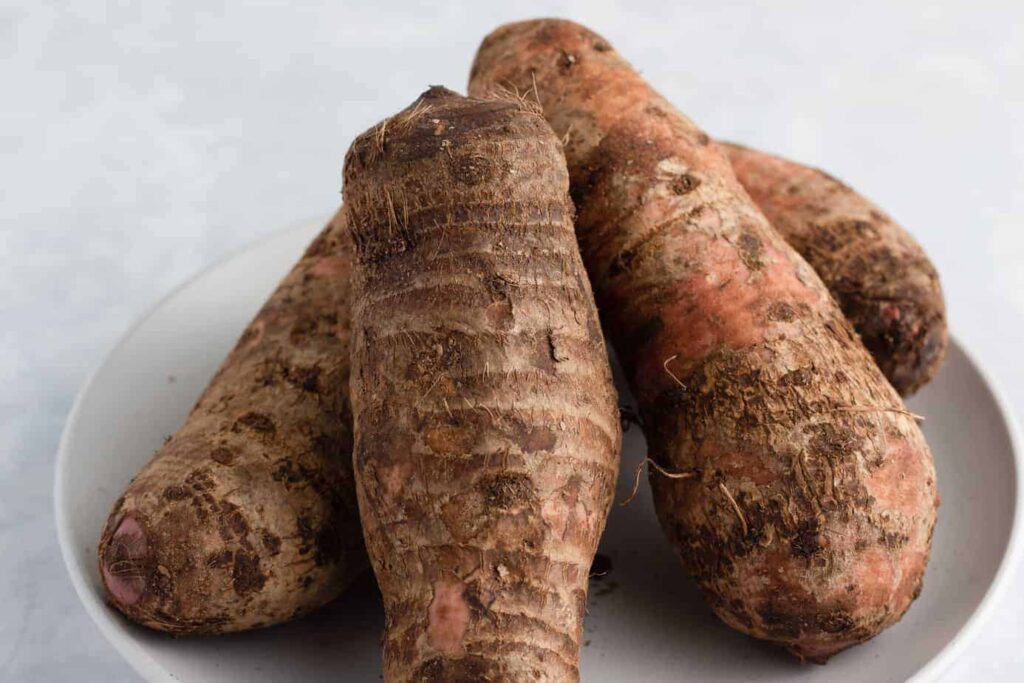Diabetes is a chronic condition that requires careful dietary management to maintain blood sugar levels. With increasing interest in natural and traditional foods, cocoyam has gained attention for its potential health benefits, particularly for individuals with diabetes. This article explores whether cocoyam is good for diabetes, its nutritional profile, potential health benefits, and safety considerations for consumption.
Understanding Cocoyam
Cocoyam is a root vegetable from the Araceae family, commonly grown in tropical regions such as Africa, Asia, and the Pacific. It comes in two primary varieties: Colocasia esculenta (Taro) and Xanthosoma sagittifolium (Tannia). The tubers are rich in carbohydrates, while the leaves are consumed as a green vegetable in many cultures.
Cocoyam is a staple food in various cuisines, valued for its starchy content, easy digestibility, and versatility in cooking. It is used in soups, stews, porridge, and snacks, making it a vital part of diets worldwide.

Nutritional Profile of Cocoyam
To assess whether cocoyam is beneficial for diabetes, it is essential to analyze its nutritional content. A 100-gram serving of boiled cocoyam typically provides:
- Calories: 112 kcal
- Carbohydrates: 26.5 g
- Fiber: 4.1 g
- Protein: 1.5 g
- Fat: 0.2 g
- Vitamin C: 5 mg
- Potassium: 484 mg
- Magnesium: 23 mg
- Calcium: 18 mg
Cocoyam contains complex carbohydrates, dietary fiber, and essential minerals like potassium and magnesium, which are crucial for metabolic health.
The Glycemic Index and Diabetes
One critical factor in determining whether a food is suitable for diabetes is its glycemic index (GI). The GI measures how quickly a carbohydrate-containing food raises blood sugar levels. Foods with a low GI (55 or less) are better for blood sugar control as they cause slower and steadier increases in glucose levels.
- Cocoyam’s Glycemic Index: While the exact GI of cocoyam varies based on preparation, it is generally considered low to moderate (40-60), making it a potentially diabetes-friendly option when consumed in moderation.
Health Benefits of Cocoyam for Diabetes
- Rich in Dietary Fiber
Cocoyam’s high fiber content plays a significant role in managing diabetes. Fiber slows down digestion and the absorption of carbohydrates, leading to a gradual rise in blood sugar. It also promotes satiety, which can help prevent overeating—a common challenge for individuals managing diabetes. - Low in Fat
Unlike many starchy foods, cocoyam is naturally low in fat, making it a heart-friendly choice. People with diabetes are at higher risk for cardiovascular complications, and low-fat diets can support heart health. - Rich in Resistant Starch
Cocoyam contains resistant starch, a type of carbohydrate that resists digestion in the small intestine. Resistant starch has been shown to improve insulin sensitivity, lower blood sugar levels, and promote gut health by feeding beneficial gut bacteria. - Contains Essential Minerals
- Potassium: Helps regulate blood pressure, which is essential since diabetes increases the risk of hypertension.
- Magnesium: Plays a role in insulin sensitivity and glucose metabolism. Magnesium deficiency is common among people with diabetes, making cocoyam a valuable addition to their diet.
- Antioxidant Properties
Cocoyam contains phenolic compounds and vitamin C, which provide antioxidant benefits. Antioxidants reduce oxidative stress, a condition associated with diabetes complications like neuropathy and retinopathy.
Scientific Studies on Cocoyam and Diabetes
Research on the specific impact of cocoyam on diabetes is limited, but several studies highlight its potential benefits:
- Blood Sugar Regulation
A study published in the Journal of Medicinal Food found that foods rich in complex carbohydrates and fiber, like cocoyam, are beneficial for glycemic control. The slow digestion of cocoyam makes it an excellent option for maintaining stable blood sugar levels. - Weight Management
Obesity is a risk factor for type 2 diabetes. Cocoyam’s fiber content promotes feelings of fullness, helping individuals manage their weight more effectively. - Improved Insulin Sensitivity
Resistant starch in cocoyam has been linked to enhanced insulin sensitivity, making it easier for the body to regulate blood sugar levels.
How to Safely Include Cocoyam in a Diabetes Diet
To maximize the benefits of cocoyam while minimizing potential risks, consider the following tips:
- Portion Control
While cocoyam has a low to moderate GI, consuming large portions can lead to excessive carbohydrate intake, potentially spiking blood sugar levels. Stick to a serving size of about 100-150 grams per meal. - Preparation Methods
- Boiling: Retains nutrients and minimizes calorie content.
- Steaming: Preserves the fiber and antioxidant properties.
- Avoid frying, as it adds unnecessary fats and calories.
- Combine with Protein and Healthy Fats
Pairing cocoyam with protein (e.g., fish, chicken, or beans) or healthy fats (e.g., avocado or olive oil) can slow digestion and further stabilize blood sugar levels. - Avoid Adding Sugars
Traditional dishes that include cocoyam often feature sugary or high-fat ingredients. Opt for recipes that use spices and herbs for flavor instead. - Monitor Blood Sugar Levels
If you are introducing cocoyam into your diet for the first time, monitor your blood sugar levels to assess how your body responds.
Risks and Considerations
Although cocoyam offers numerous benefits, there are some potential drawbacks:
- High Carb Content
Cocoyam is carbohydrate-rich, which can pose challenges for individuals on strict carbohydrate-restricted diets. Balance is key. - Allergic Reactions
Some people may experience allergic reactions to cocoyam, particularly its raw form. Always cook cocoyam thoroughly to neutralize potential irritants. - Oxalate Content
Cocoyam contains oxalates, which can contribute to kidney stone formation in susceptible individuals. If you have a history of kidney stones, consult your doctor before including cocoyam in your diet. - Variation in GI Based on Cooking
Overcooking or mashing cocoyam may raise its glycemic index, making it less ideal for blood sugar control. Stick to boiling or steaming.
Alternatives to Cocoyam for Diabetes
While cocoyam is a nutritious choice, individuals with diabetes can also consider other root vegetables and low-GI foods, such as:
- Sweet Potatoes: Rich in fiber and antioxidants.
- Yams: Have a low to moderate GI and are nutrient-dense.
- Pumpkin: A low-carb alternative with anti-diabetic properties.
- Plantains: When unripe, they have a lower GI and are a good source of resistant starch.
Final Thoughts
Cocoyam can be a healthy addition to a diabetes-friendly diet when consumed in moderation and prepared properly. Its fiber content, low GI, and rich nutrient profile make it a valuable food for blood sugar management and overall health. However, portion control and individual responses to cocoyam should always be considered.
As with any dietary change, it is crucial to consult a healthcare professional or dietitian to ensure that cocoyam aligns with your individual dietary needs and diabetes management plan. By incorporating cocoyam and other nutrient-rich foods into a balanced diet, individuals with diabetes can enjoy a diverse and healthful menu while maintaining optimal blood sugar control.

